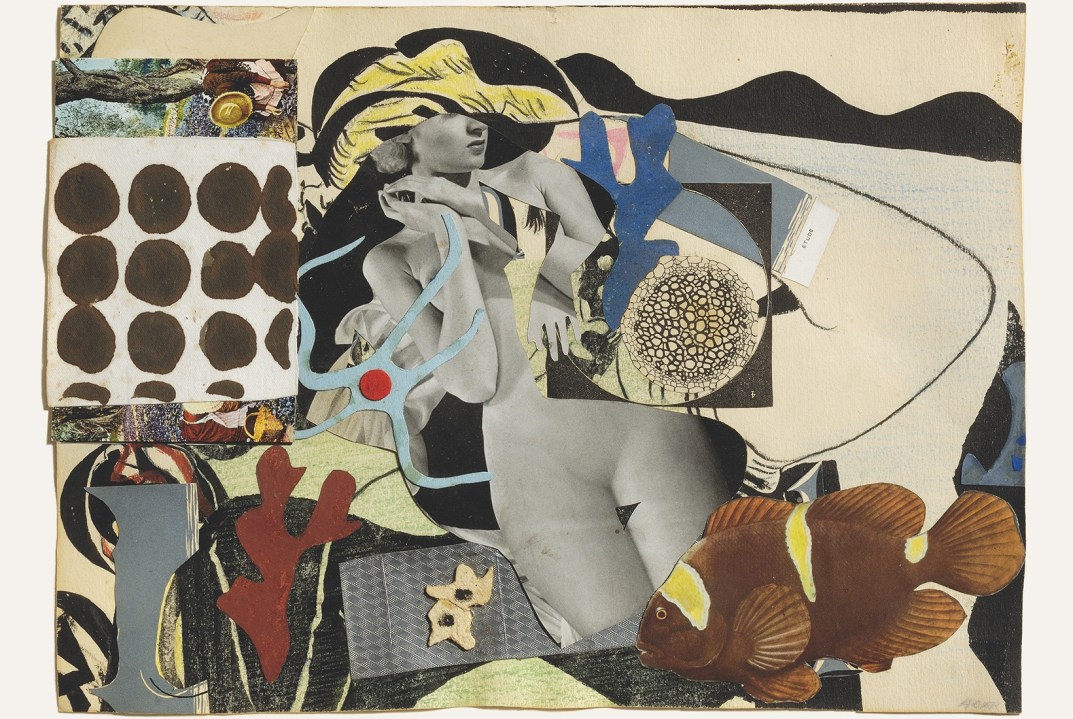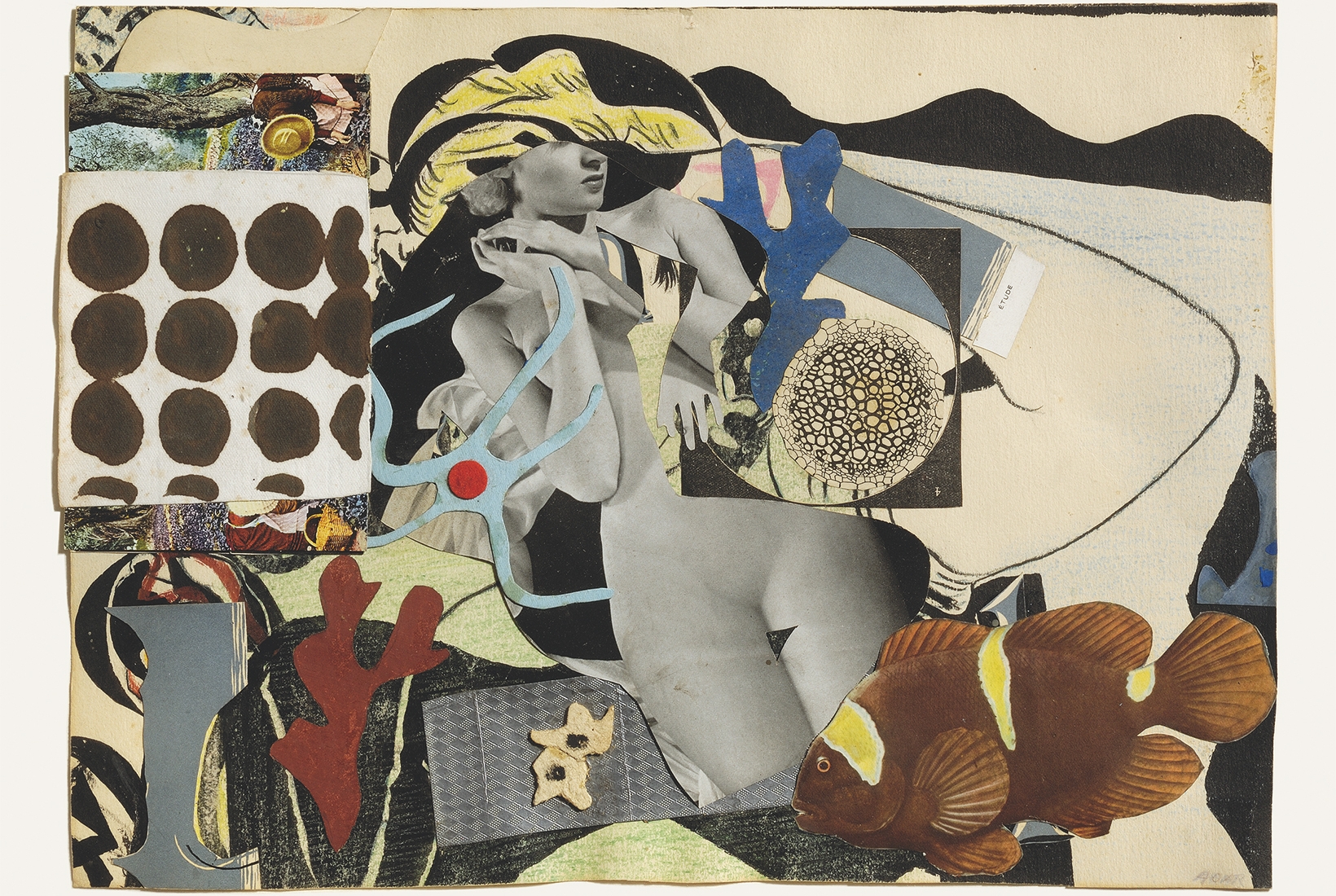Heads turn, strangers gawp, matrons tut or look in envy. A man doffs his bowler hat knowing when he is outdone. The model walking imperturbably along a London street is Eileen Agar, her headwear the ‘Ceremonial Hat for Eating Bouillabaisse’, encrusted with crustaceans, spangled with starfish. If the Little Mermaid,in her leggy period, had been invited to Ascot, she might have worn something like this. A British Pathé newsreel of Agar wearing the same hat plays on a loop in the Eileen Agar: Angel of Anarchy exhibition at the Whitechapel Gallery. (You can also see it on YouTube.) About 50 seconds in you catch her trying not to smile.
‘Life’s meaning is lost without the spirit of play,’ Agar wrote in one of her notebooks. ‘In play all that is gay, lovely and soaring in the human spirit strives to find expression. To play is to yield oneself to a kind of magic. In play the mind is prepared to accept the unimagined and incredible, to enter a world where different laws apply, to be free, unfettered and divine.’ This show is unfettered fun from start to finish. Agar’s exuberance bursts forth in drawing and collage, painting and curious assemblage.
No prim Victorian Miss ever cut and pasted a composition as lawless as Agar’s Untitled Collage (1936)
She was born in Buenos Aires on 1 December 1899 to a Scottish industrialist father and an American heiress mother. She was sent to school in England aged six and after the encouragement of Lucy Kemp-Welch, a teacher at Heathfield, she studied under the painter Leon Underwood at the Brook Green School of Art before taking up a place at the Slade in 1921. Her father’s death left her with an inheritance and the liberty to do as she pleased. She was elfin in person, impish in spirit. Picasso took a shine to her because she was even smaller than he was (5ft 3in). She married her fellow Slade student Robin Bartlett in 1925. Too young. A year later she met the Hungarian writer Joseph Bard who would be her companion for the next 50 years and, in 1940, her second husband. In Paris, Agar met the surrealists André Breton and Paul Éluard and took painting lessons from the Czech cubist Frantisek Foltyn. Agar lived until a week after her 91st birthday, wonderfully weird to the end.
Agar was a surrealist with a little s, not a big S, said her lover and collaborator Paul Nash. A sui generis surrealist, then, belonging to no movement but her own. But how she moved. The first room is dedicated to Agar’s portraits, self-portraits and drawings of the 1920s and early 1930s. They are Picasso-esque and uncertain. It is as if she is trying to speak not just another man’s language, but in another man’s voice.
After 1933 or so it is a different kettle of bouillabaisse. There is a sense of pinwheeling freedom. We follow her into uncharted waters, off the map and over the edge. Two ghoulish heads greet us in glass vitrines. The first is the ‘Angel of Anarchy’ (1936-1940) which gives the show its title. The Angel started as a plaster bust of Bard, given a carapace of doilies and fur, seashells and ostrich feathers, the skull of a seagull and the gemstones from the buckles of Agar’s mother’s evening slippers. This version, lost or destroyed, was remade as a great flamboyant totem. The nose is set with glittering stones, the neck is threaded with Frankenstein seams, a fringe of cowrie shells frames an uncanny face. More stripped back, though no less bizarre, is the ‘Angel of Mercy’ (c.1934) with its dice for a nose, its spiralling snail shell chin and its crown of plaster pebbles and thorns.
It is in Agar’s collages that we truly see the artist at play. She delights in flotsam and jetsam, odds and ends, bits and beachcombing bobs. ‘Fantastic bric-à-brac’, she called it. Bard was a connoisseur and collector of ancient gems and in ‘Precious Stones’ (1936; see p31) she cut his portrait like a Roman cameo in a silhouette snipped from a guide to antique medals and jewels. Elsewhere, her materials are bones and horns, fossils and seaweeds and, in the case of one untitled box made in 1935, a single desiccated seahorse. Agar and Nash used to meet in the Natural History Museum and the Science Museum to look at butterflies and stones. Hers is an Ariel’s Song: ‘Of his bones are coral made/ Those are pearls that were his eyes.’ One of her works, marbled, lagoonish, is called ‘Sea Nymph’ (1950). Agar takes the tradition of Victorian decoupage, flower-pressing and album-making and gives it a turn of the screw. No prim Victorian Miss ever cut and pasted a composition as lawless as Agar’s ‘Untitled Collage’ (1936) with its sinister lacework and squid-like stickers. Even the sycamore seeds start to look like crocodile jaws.
Not all of it is unnerving. ‘Fish Basket’ (1965) is like a lobster trap designed by Matisse. The starfish in ‘Etoiles de Mer’ (undated) seem to shimmy on the shingle. Will you, won’t you, will you, won’t you, will you join the dance? Agar in Wonderland.
Upstairs, her black-and-white photographs of rocks at Ploumanach, taken in Brittany in 1936, show that nature needs no intervention to be rendered surreal. Her acrylic paintings of the 1970s feel flat and unsatisfying after the layering and accretions of the collaged works elsewhere. Still, in its richness and strangeness, its wildness and wit, this is a five star(fish) show.







Comments